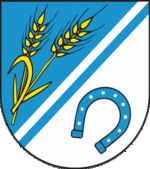Glebitzsch: Difference between revisions
Jump to navigation
Jump to search
Knorrepoes (talk | contribs) m (Text replacement - "|'''English''' ↵| {{blazon wanted}}" to "|'''English''' | blazon wanted") |
Knorrepoes (talk | contribs) m (Text replacement - "↵↵{{de1}}↵{{media1}}↵↵'''Literature''': - ↵↵[[Category" to " '''Literature''': - {{de1}} {{media1}} [[Category") Tags: Mobile edit Mobile web edit |
||
| Line 26: | Line 26: | ||
The two wheat-ears and the horseshoe refer to the agricultural character of the two villages of Beyersdorf and Köckern. The horseshoe also refers to the historical shape of both villages. | The two wheat-ears and the horseshoe refer to the agricultural character of the two villages of Beyersdorf and Köckern. The horseshoe also refers to the historical shape of both villages. | ||
[[Civic Heraldry Literature - Germany|'''Literature''']]: - | |||
{{de1}} | {{de1}} | ||
{{media1}} | {{media1}} | ||
[[Category:German Municipalities G]] | [[Category:German Municipalities G]] | ||
Revision as of 05:34, 16 July 2023
GLEBITZSCH
State : Sachsen-Anhalt
District (Kreis) : Anhalt-Bitterfeld (until 2008 Bitterfeld)
Additions : 1950 Beyersdorf (1928 Julishof), Köckern
Incorporated into : 2009 Sandersdorf-Brehna
| German |
Von Blau und Silber schräglinks geteilt, die Teilung belegt mit einer in verwechselten Farben geschrägter Leiste; oben zwei goldene Ähren am Halm mit Blättern, unten ein mit den Stollen nach abwärts gekehrtes, nach der Teilung gestelltes blaues Hufeisen mit eckigen Nagellöchern. |
| English | blazon wanted |
Origin/meaning
The arms were officially granted on ??-??-2005.
The two wheat-ears and the horseshoe refer to the agricultural character of the two villages of Beyersdorf and Köckern. The horseshoe also refers to the historical shape of both villages.
Literature: -
